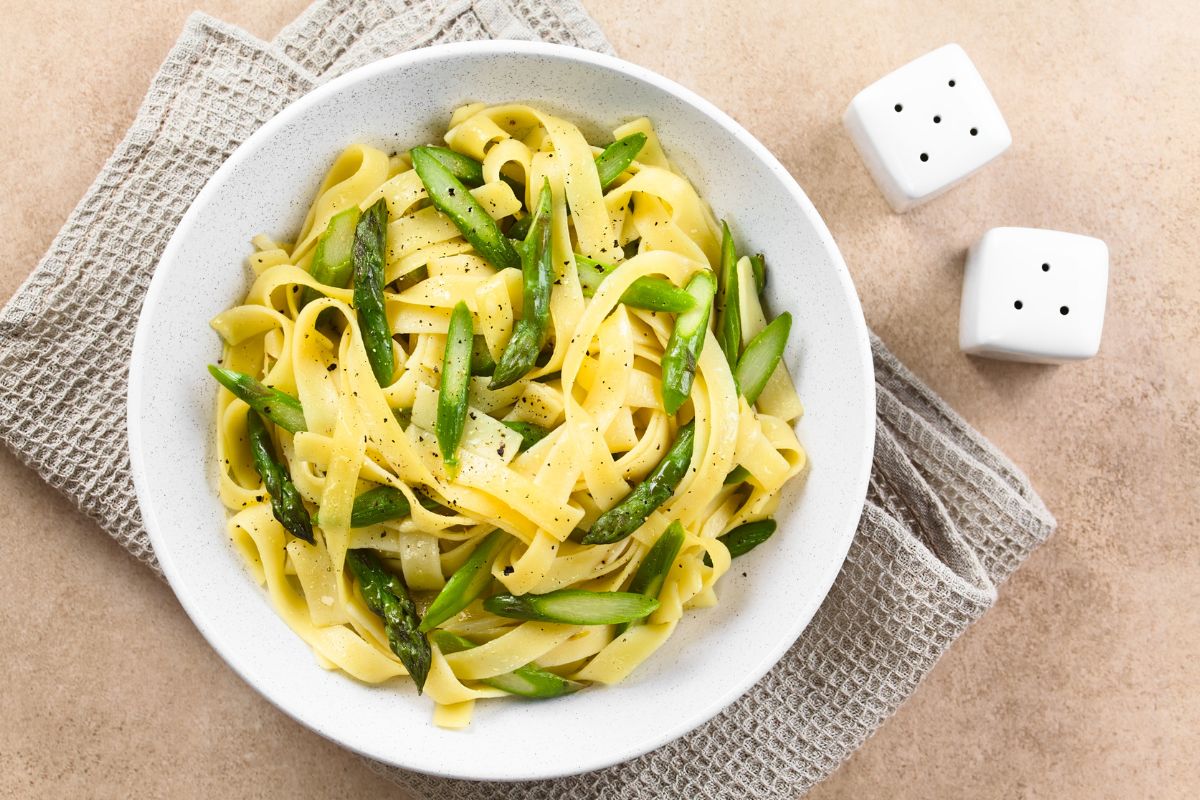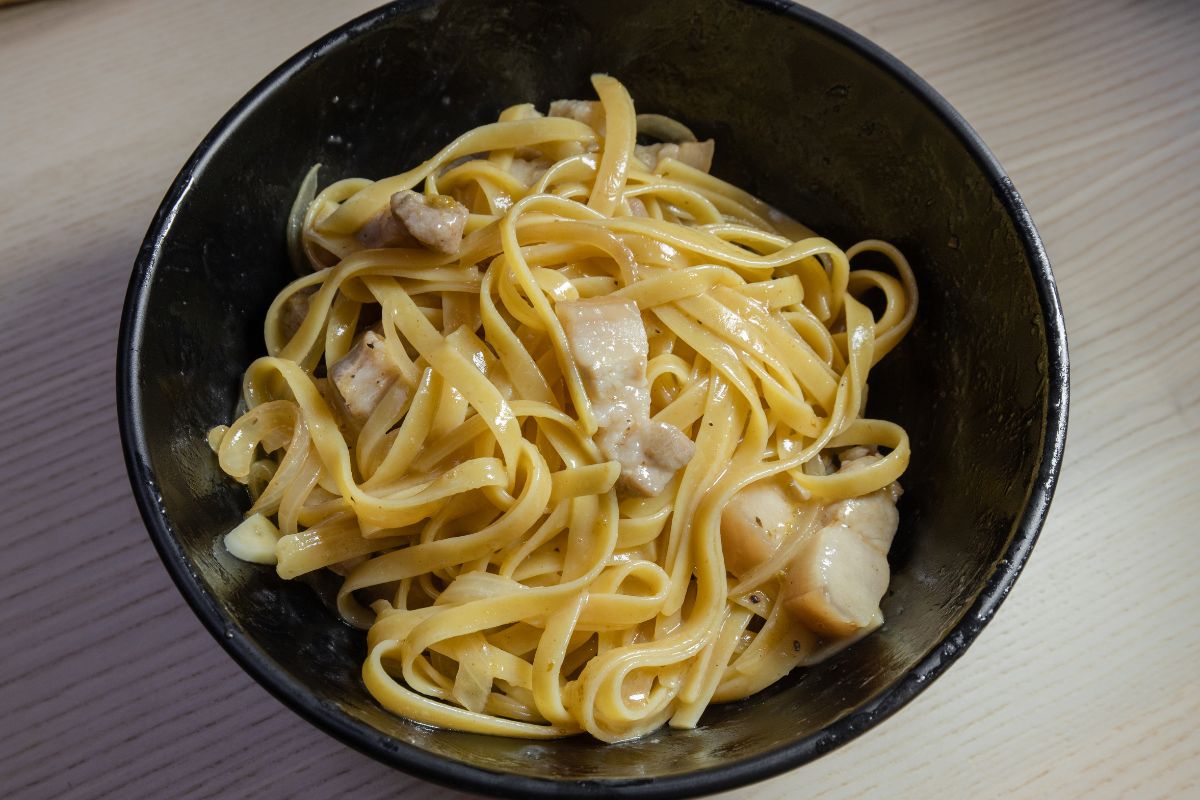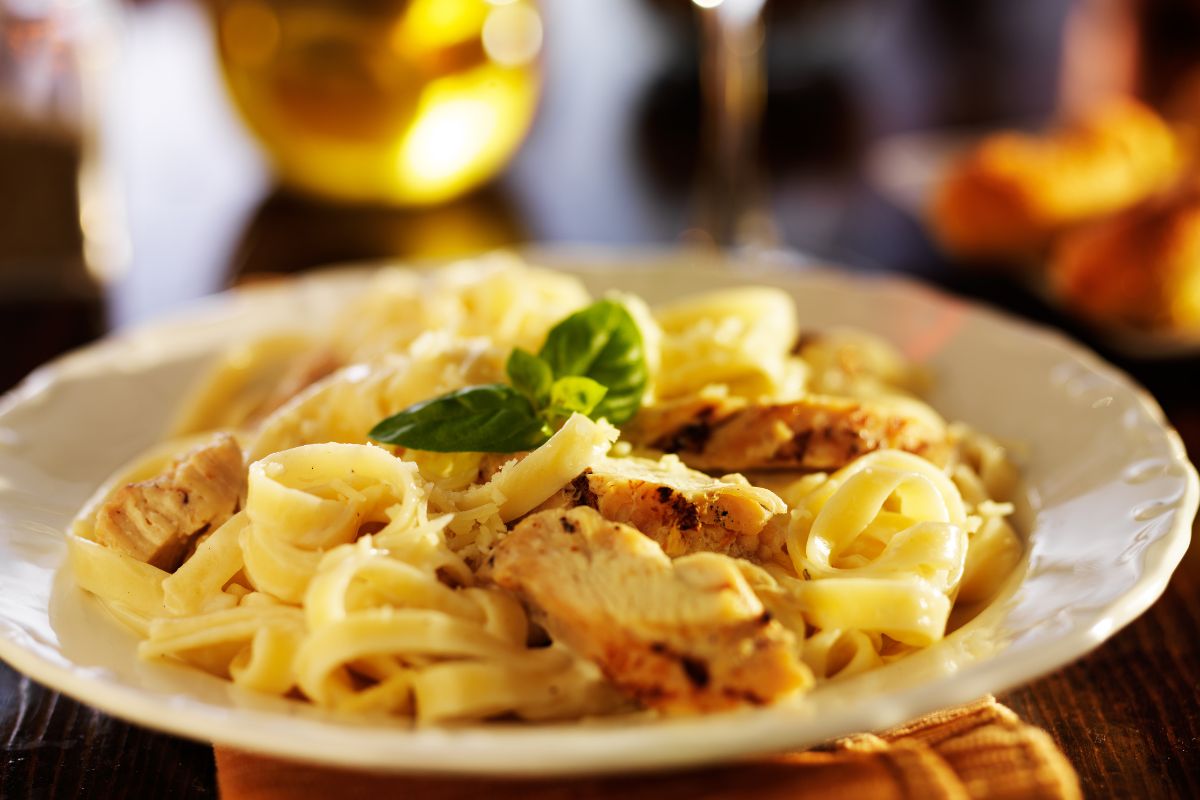Fettuccine Noodles
This article highlights how long to cook fettuccine noodles. Fettuccine noodles are special in Italian cooking, and people enjoy them worldwide. Originating in Italy, these smooth pasta strips perfectly blend simplicity and deliciousness.
This super versatile pasta works well in classic dishes and new, creative recipes. Get ready to learn more about fettuccine’s charm and tasty possibilities as we uncover the secrets behind this pasta perfection.

How Long to Cook Fettuccine Noodles
Cooking Pasta For Warm Sauce
Time: 15 minutes
Serving size: 3 servings
Prep time: 3 minutes
Cook time: 12 minutes
Nutritional Facts
- Calories: 221
- Fat: 1.3 g
- Carbohydrates: 43.2 g
- Protein: 8.1 g
- Fiber: 2.5 g
- Sodium: 1 mg
- Sugar: 0.8 g
Equipment Needed
- Large pot
- Timer
- Strainer
Ingredients
- 6 quarts (5.7 liters) of water
- Salt (to taste)
- 1 pound (0.5 kilograms) dried pasta of your choice
- ½ cup olive oil
Directions
- Fill a large pot with 6 quarts (5.7 liters) of water and let it boil. Add a salt to taste.
- Once the water reaches a rolling boil, introduce the dried pasta into the pot and stir until the water resumes boiling. Set a timer for one minute less than the recommended duration on the package instructions.
- Assess for doneness at this stage; if you desire your pasta to be firm (al dente) or intend to simmer it in sauce, check and remove it one minute earlier.
- Strain the pasta and let it cool briefly, but avoid rinsing. Rinsing removes the starch that helps the sauce adhere to the pasta. Instead, toss the pasta in olive oil to prevent sticking.
- When ready to use the pasta, add it to a warm sauce, toss it, and finish cooking. Alternatively, you can chill it for later use.
How to Make Fettuccine Noodles From Scratch
Time: 1 hour 10 minutes
Serving size: 3-4 servings
Prep time: 60 minutes
Cook time: 10 minutes
Nutritional Facts
- Calories per 100g: 272 kcal
Equipment Needed
- Rolling pin
- Fork
- Pasta cutter or knife
- Scraper
- Compact bowl
- Cloth or plastic wrap
- Dishtowel
- Large pot
Ingredients
- 7 ounces (200g) “00” flour (plus more for the work surface)
- 2 large eggs
Directions
Step 1: Making the Dough
- Begin by creating a neat pile of flour on a clean marble or wooden work surface.
- Form a well in the center flour mound’s center, ensuring it is spacious enough to accommodate the two eggs.
- Crack the eggs into the well.
- Use a fork to beat the eggs in the well, gradually pulling the flour from the sides until the eggs are completely absorbed. Use your hands and a scraper to integrate the flour further as the mixture thickens. Continue mixing until a cohesive ball of dough forms.
Step 2: Kneading the Dough
- Start by cleaning your work surface, removing all excess flour or unincorporated dough bits. Lightly dust the now-clean surface with flour.
- Knead the dough by pressing the base of one hand into the ball with your fingers raised.
- Press down on the dough while simultaneously pushing it firmly away from you. This action should result in the dough stretching and rolling under your hand, forming a shell-like shape.
- Flip the dough over and, using your knuckles, press into the dough one hand at a time. Repeat this process approximately 10 times.
- Roll the dough back into a ball and reiterate the stretching and knuckling process, adding more flour if necessary to prevent stickiness.
- Continue this kneading procedure for approximately 10-20 minutes until the dough achieves a smooth and silky texture.
- Finally, shape the dough into a smooth ball.
Step 3: Letting the Dough Rest
- Transfer the dough to a compact bowl and then cover it with a cloth or plastic wrap.
- Let the dough rest for at least thirty minutes at room temperature, or refrigerate it for up to one day.
- If you refrigerate the dough, let it sit for one hour at room temperature before rolling and shaping it into a circle.
Step 4: Rolling the Pasta
- Sprinkle a small amount of flour onto your work surface.
- Shape the dough into a circle.
- Start rolling the dough from the center and moving it outward, like rolling out pastry crust.
- Rotate the dough a quarter-turn and repeat the rolling process, working your way around, until the dough sheet is 1/8 inch (0.3 centimeters) thin or thinner. Add a touch of flour whenever the dough sticks to the surface or rolling pin.
Step 5: Cutting the Pasta
- Take the dough, now known as Foglia, and position it on a clean, lightly floured work surface.
- Roll the dough over itself carefully, ensuring you use sufficient flour to prevent sticking.
- Using the pasta cutter or knife, trim the end edges to achieve an even surface, then cut the dough into approximately 6 millimeters (0.6 centimeters) wide strips.
- Lift the pasta strips gently into the air and place them carefully on a dishtowel, ensuring you separate them.
- Repeat the same process with the remaining sheets of dough.
- Now, you’re ready to cook your pasta.
Step 6: Cooking the Pasta
- With your freshly made fettuccine ready,bring a large pot of water to a boil and add salt to taste.
- Put the pasta in boiling water and cook for three to four minutes, tasting for al dente perfection before removing it.
- Strain the pasta and mix it with your chosen sauce.
- Your delicious dish is ready. Enjoy!

How to Know When Fettuccine Noodles Are Done
Determining when fettuccine noodles are done is crucial for achieving the desired texture. Here’s a simple guide to help you know when your fettuccine noodles are ready:
- Visual inspection: You can cut a piece of the pasta in half and check the center. If it has a uniform color throughout and there’s no white ring or spot, it’s ready.
- Taste test: The most reliable method is to taste a piece. The term “al dente,” meaning “to the tooth” in Italian, suggests that pasta should be firm but tender when bitten. Take a small piece and test for the desired level of doneness.
- Check package instructions: Refer to the package instructions for recommended cooking times. However, consider that these times can vary, and your preference plays a significant role in achieving the perfect texture.
Remember, pasta continues to cook briefly after draining, especially if you cook it further in a sauce. It’s advisable to slightly undercook it if you plan to finish cooking it in the sauce. With some practice, you’ll become adept at determining the ideal doneness for your fettuccine noodles.
Our Top Fettuccine Cooking Tips
- Use a large pot: Ensure enough space and water to prevent clumping during cooking for delicious and easy-to-toss pasta.
- Fill the pot with cold water: Cold water reduces the risk of impurities from pipes, and covering it with a lid helps it boil more quickly.
- Add salt to boiling water: Enhance flavor by adding two tablespoons of salt per pound of pasta once the water is boiling. Stir to ensure complete salt dissolution.
- Consistently mix the pasta: Stir regularly to prevent clumping and ensure even cooking.
- Avoid covering the pot once you add the pasta: If it’s boiling over, reduce the heat slightly.
- Drain pasta promptly: Reserve ¼-cup of pasta water for sauce; do not rinse unless the recipe specifies, as starch aids sauce adherence. Keep drained pasta warm in the pot to prevent drying out; do not mix different pasta types in one pot.
What is the Best Way to Store Fettuccine Noodles?
Placing fettuccine noodles in an airtight container or sealed bag is crucial for properly storing it. This helps prevent dryness and absorbing any unwanted odors from surrounding foods. Consider these guidelines on how to store your fettuccine noodles effectively:
Fresh Pasta
You can refrigerate fresh fettuccine noodles for up to two days or freeze them for two months. Store fresh pasta in an airtight container or a freezer bag, removing as much air as possible.
You can also freeze fresh pasta by forming it into nests and placing them on a baking sheet lined with parchment paper. Once frozen, transfer the nests to an airtight container or freezer bag.
Cooked Pasta
You can store cooked fettuccine noodles in the refrigerator for five days or freeze them for two months. Place cooked pasta in an airtight container or bag to store it properly, ensuring there’s minimal air trapped inside. Additionally, consider tossing the pasta with a little olive oil or butter to prevent sticking.
Dried Pasta
Store dried fettuccine noodles in a cool, dry place within an airtight container for two years. To preserve fettuccine noodles effectively, utilize an airtight container or bag when storing them in the refrigerator or freezer.
What are Some Popular Fettuccine Noodle Dishes?
Fettuccine noodles are a versatile pasta that you can use in various dishes. Here are some popular fettuccine noodle dishes:
- Fettuccine Alfredo: A classic Italian dish made with butter, cream, and Parmigiano Reggiano cheese. You make the sauce by melting butter in a pan, adding cream, and stirring in grated Parmigiano Reggiano cheese until it forms a smooth sauce. You then toss the cooked fettuccine in the sauce and serve hot.
- Carbonara: A traditional Italian dish made with eggs, pancetta or bacon, and Parmigiano Reggiano cheese. You make the sauce by whisking eggs, cheese, and black pepper together and then tossing the cooked fettuccine noodles with the sauce and crispy pancetta or bacon.
- Seafood Fettuccine: A dish that combines fettuccine noodles with various seafood, such as shrimp, scallops, and clams. The seafood is typically sautéed with garlic and olive oil and then tossed with the cooked fettuccine noodles and a light tomato or white wine sauce.
- Fettuccine With Mushrooms: A vegetarian dish that combines fettuccine noodles with sautéed mushrooms, garlic, and herbs. You cook the mushrooms in butter or olive oil and then toss with the cooked fettuccine noodles and grated Parmigiano Reggiano cheese.
- Fettuccine With Meat Sauce: A hearty dish that combines fettuccine noodles with a rich meat sauce, such as Bolognese or ragù. You make this meat sauce with ground beef or pork, tomatoes, and herbs and then simmer until thick and flavorful. You then toss the cooked fettuccine noodles with the meat sauce and serve hot.
How Long to Cook Fettuccine Noodles in an Instant Pot
On high pressure, cook fettuccine noodles in an instant pot for approximately three to four minutes. Adjust based on thickness and personal preferences. Remember that these are general guidelines, and you may need to adjust the cooking time based on your specific instant pot model and preferences for pasta doneness.
How Long to Cook Fettuccine Noodles, Al Dente
Typically, fettuccine noodles take around eight to ten minutes to cook al dente on the stovetop. However, it’s always advisable to check the package instructions for specific cooking times, as they may vary based on the brand and type of fettuccine.
When cooking for al dente, it’s a good idea to start testing for doneness a minute or two before the recommended time to ensure the pasta retains a firm texture.

That’s a Wrap
In conclusion, mastering the art of cooking noodles is not merely about adhering to a specific timeframe but a blend of visual cues, taste preferences, and a touch of culinary intuition. The versatility of fettuccine allows for a range of cooking styles, from classic al dente to softer variations, catering to individual tastes.
Whether you rely on fettuccine pasta box instructions, visual assessments, or a reliable taste test, the key lies in achieving the ideal balance of firmness and tenderness that suits your palate.
You now know how to cook fettuccine pasta, so the next time you embark on a cooking adventure, embrace the culinary journey and let your taste preferences guide you to pasta perfection.

Community of passionate writers and content creators who share a love for Italian heritage, culture, travel, food, and the Italian-American community. Our mission is to celebrate Italy’s rich history and traditions and connect with others who share the same passion.


